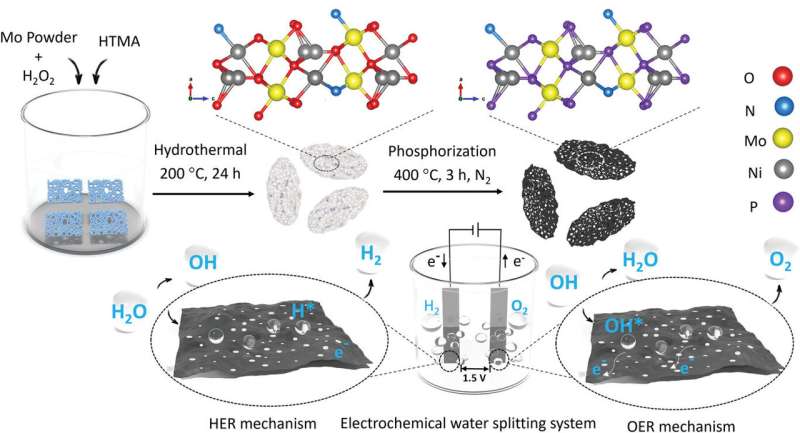This article has been reviewed according to Science X's editorial process and policies. Editors have highlighted the following attributes while ensuring the content's credibility:
fact-checked
peer-reviewed publication
trusted source
proofread
How to make hydrogen straight from seawater, with no desalination required

Researchers have developed a cheaper and more energy-efficient way to make hydrogen directly from seawater, in a critical step towards a truly viable green hydrogen industry.
The new method from RMIT University researchers splits the seawater directly into hydrogen and oxygen—skipping the need for desalination and its associated cost, energy consumption and carbon emissions.
Hydrogen has long been touted as a clean future fuel and a potential solution to critical energy challenges, especially for industries that are harder to decarbonize like manufacturing, aviation and shipping.
Almost all the world's hydrogen currently comes from fossil fuels and its production is responsible for about 830 million tons of carbon dioxide a year, equivalent to the annual emissions of the United Kingdom and Indonesia combined.
But emissions-free "green" hydrogen, made by splitting water, is so expensive that it is largely commercially unviable and accounts for just 1% of total hydrogen production globally.
Lead researcher Dr. Nasir Mahmood, a Vice-Chancellor's Senior Research Fellow at RMIT, said green hydrogen production processes were both costly and relied on fresh or desalinated water.
"We know hydrogen has immense potential as a clean energy source, particularly for the many industries that can't easily switch over to be powered by renewables," Mahmood said.
"But to be truly sustainable, the hydrogen we use must be 100% carbon-free across the entire production life cycle and must not cut into the world's precious freshwater reserves.
"Our method to produce hydrogen straight from seawater is simple, scalable and far more cost-effective than any green hydrogen approach currently in the market.
"With further development, we hope this could advance the establishment of a thriving green hydrogen industry in Australia."
A provisional patent application has been filed for the new method, detailed in a lab-scale study published in the journal Small.
Splitting the difference: A catalyst for seawater
To make green hydrogen, an electrolyzer is used to send an electric current through water to split it into its component elements of hydrogen and oxygen.
These electrolyzers currently use expensive catalysts and consume a lot of energy and water; it can take about nine liters to make one kilogram of hydrogen. They also have a toxic output—not carbon dioxide, but chlorine.
"The biggest hurdle with using seawater is the chlorine, which can be produced as a by-product. If we were to meet the world's hydrogen needs without solving this issue first, we'd produce 240 million tons per year of chlorine each year—which is three to four times what the world needs in chlorine. There's no point replacing hydrogen made by fossil fuels with hydrogen production that could be damaging our environment in a different way," Mahmood said.
"Our process not only omits carbon dioxide, but also has no chlorine production."
The new approach devised by a team in the multidisciplinary Materials for Clean Energy and Environment (MC2E) research group at RMIT uses a special type of catalyst developed to work specifically with seawater.
The study, with Ph.D. candidate Suraj Loomba, focused on producing highly efficient, stable catalysts that can be manufactured cost-effectively.
"These new catalysts take very little energy to run and could be used at room temperature," Mahmood said.
"While other experimental catalysts have been developed for seawater splitting, they are complex and hard to scale.
"Our approach focused on changing the internal chemistry of the catalysts through a simple method, which makes them relatively easy to produce at large-scale so they can be readily synthesized at industrial scales," Loomba said.
Mahmood said the technology had promise to significantly bring down the cost of electrolyzers—enough to meet the Australian Government's goal for green hydrogen production of $2/kilogram, to make it competitive with fossil fuel-sourced hydrogen.
The researchers at RMIT are working with industry partners to develop aspects of this technology.
The next stage in the research is the development of a prototype electrolyzer that combines a series of catalysts to produce large quantities of hydrogen.
More information: Suraj Loomba et al, Nitrogen‐Doped Porous Nickel Molybdenum Phosphide Sheets for Efficient Seawater Splitting, Small (2023). DOI: 10.1002/smll.202207310


















